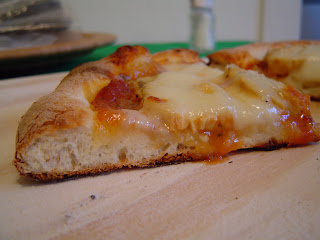 I love peach cobbler. Last year I got delicious peaches while working in Roanoke, Virginia. This year, I'm in Massachusetts, but I've managed to find some decent peaches. I don't know exactly what recipe I used last year, but I'm starting with this one (note: the "Grandma's Peach Cobbler", not the "Old Fashioned Peach Cobbler"). This cobbler is a sweet, buttery cake stuffed with peaches. Simply melt 1 stick of butter in a pan. Then mix 1 cup each of milk, flour, and sugar plus salt and baking powder. The batter goes into the pan over the butter and then the peaches are loaded on top. The batter rises and cooks around the peaches and it's very delicious.
I love peach cobbler. Last year I got delicious peaches while working in Roanoke, Virginia. This year, I'm in Massachusetts, but I've managed to find some decent peaches. I don't know exactly what recipe I used last year, but I'm starting with this one (note: the "Grandma's Peach Cobbler", not the "Old Fashioned Peach Cobbler"). This cobbler is a sweet, buttery cake stuffed with peaches. Simply melt 1 stick of butter in a pan. Then mix 1 cup each of milk, flour, and sugar plus salt and baking powder. The batter goes into the pan over the butter and then the peaches are loaded on top. The batter rises and cooks around the peaches and it's very delicious.Recently I've had a few issues with this recipe. The batter was a little thin, and last year I don't think I used 1 cup for all three ingredients. So I decreased the milk to 3/4 cup. This yields a good batter consistency. Also, since I did this in an 8x8 pan instead of a 9x13, the middle was a bit uncooked. I prefer cobbler to be thick, and the prescribed amount of peaches and batter is just right for an 8x8 pan, but not enough for a 9x13. I think I'll need to decrease the temperature maybe to 325 degrees or so, and increase the time to maybe an hour (it took 45 minutes at 350).
Sadly, next time I think I will decrease the butter. I love how the cake becomes extremely buttery (almost like it's fried in butter), but I really should consider my cardiovascular health. I think I could probably decrease the butter to 3/4 stick, or even 1/2 stick.





























